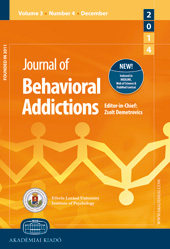Pilot Clinical Observations Between Food and Drug Seeking Derived from Fifty Cases Attending an Eating Disorder Clinic
Pilot Clinical Observations Between Food and Drug Seeking Derived from Fifty Cases Attending an Eating Disorder Clinic
Author(s): Harriet Beitscher-Campbell, Kenneth Blum, Marcelo Febo, Margaret Madigan, John Giordano, Rajendra D. Badgaiyan, Eric R. Braverman, Kristina Dushaj, Mona Li, Mark S. GoldSubject(s): Neuropsychology, Clinical psychology, Behaviorism, Substance abuse and addiction, Health and medicine and law
Published by: Akadémiai Kiadó
Keywords: food and drug addictions; commonality; dopamine pathways; reward deficiency syndrome; eating disorder;
Summary/Abstract: The reward deficiency syndrome hypothesis posits that genes are responsible for reward dependence and related behaviors. There is evidence that both bulimia and anorexia nervosa, especially in women, have been linked to a lifetime history of substance use disorder (SUD). There are difficulties in accepting food as an addiction similar to drugs; however, increasingly neuroimaging studies favor such an assertion. Case presentations: We are reporting the evidence of comorbidity of eating disorders with SUD found within these case presentations. We show 50 case reports derived from two independent treatment centers in Florida that suggest the commonality between food and drug addictions. In an attempt to provide data from this cohort, many participants did not adequately respond to our questionnaire. Discussion: We propose that dopamine agonist therapy may be of common benefit. Failure in the past may reside in too powerful D2 agonist activity leading to D2 receptor downregulation, while the new methodology may cause a reduction of “dopamine resistance” by inducing “dopamine homeostasis.” While this is not a definitive study, it does provide some additional clinical evidence that these two addictions are not mutually exclusive. Conclusion: Certainly, it is our position that there is an overlap between food- and drug-seeking behavior. We propose that the studies focused on an effort to produce natural activation of dopaminergic reward circuitry as a type of common therapy may certainly be reasonable. Additional research is warranted.
Journal: Journal of Behavioral Addictions
- Issue Year: 5/2016
- Issue No: 3
- Page Range: 533-541
- Page Count: 9
- Language: English

